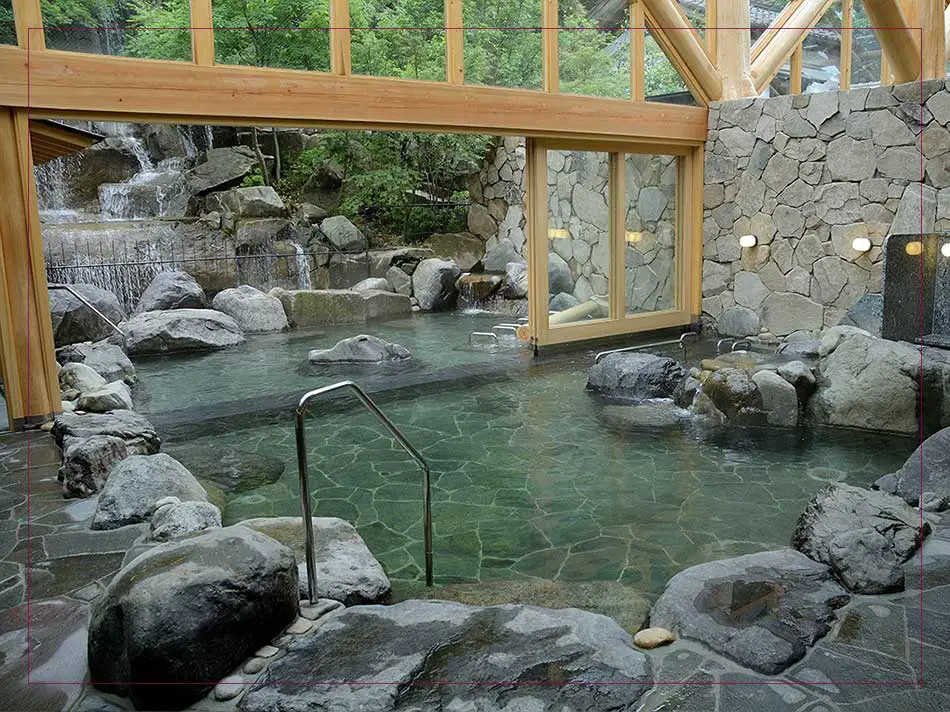The time you can stay in a hot spring depends a lot on your physical condition and heat tolerance. But did you know that there are actual recommendations for how many minutes you should soak in an onsen? Here is what I have found.
How long should you stay in a hot spring? The recommended bathing time for onsen depends on the water temperature and ranges from 5-40 minutes. If the hot spring water is 42°C warm you shouldn’t stay longer than 5 minutes. If it’s 36°C you can soak for up to 40 minutes. As a general rule, the hotter the water, the shorter you should stay.
This is an important rule to keep in mind when visiting an onsen because staying in the bath too long or soaking too many times per day could actually be dangerous. If you are curious about the bathing time for each water temperature you will find the detailed numbers below. I will also explain to you how you can extend your soaking time in a safe way.
Recommended Bathing Time to Soak up the Onsen Benefits
The common answer for how long you should soak in a hot spring is usually 10 to 20 minutes. But be careful! This is not the recommendation of Japanese onsen experts. This number is just a norm that represents the average time onsen visitors tend to soak in a hot spring.
Japanese onsen experts recommend different bathing times for each water temperature. The maximum time you should soak in 42°C hot bathwater, for example, is 5 minutes. While the maximum bathing time you can stay in 36°C lukewarm water is 40 minutes.
Here’s a detailed overview of different water temperatures and the recommended maximum bathing time for each:
- 42°C: 5 minutes
- 41°C: 10 minutes
- 40°C: 15 minutes
- 39°C: 20 minutes
- 38°C: 25 minutes
- 37°C: 30 minutes
- 36°C: 40 minutes
Especially for hot spring water over 39°C, you should take the recommended maximum bathing time seriously. Cause otherwise, you could suffer from dehydration and might even faint while you are in the water. For water temperatures below 39°C, it is okay if you are a little bit less strict, though. I personally have bathed in 38°C warm water for more than 30 minutes without any issues.
How Long do You Have to Stay in The Water to Soak up the Onsen Benefits?
So now that we know the recommended maximum bathing time for hot springs, you might wonder what the recommended minimum soaking time is.
The good news is that there is nothing like a recommended minimum bathing time for your soak in a hot spring. Once you enter the hot spring you will immediately benefit from its health and beauty effects. But then again the longer you stay in an onsen the more you will sweat and the more your blood circulation will be stimulated, which is good for your health and your body.
As a general rule of thumb, you should stay in the onsen until you start sweating. You can stay in the onsen for as long as your heart doesn’t beat too fast and you should get out of the bathtub once you start to get sweaty or your pulse rate is more than 120 beats per minute.
But this is just a general recommendation. Elderly people and people with weak hearts should stay shorter while people that are resistant to heat can soak in the onsen a bit longer. If you are pregnant it is okay to take a hot spring bath. Just be careful and don’t overdo it because you might get dizzy or suffer from nausea more easily.
Try to listen to your body and immediately get out of the hot water when you feel sick, dizzy or lightheaded.
Risks of Staying Too Long in a Hot Spring
Even though soaking in a hot spring has a lot of health and beauty benefits there are also a few things you should be wary about. Very similar to a hot bath at home, soaking in an onsen can hold several health risks depending on the temperature of the water and the duration of your bath.
The hot spring’s biggest benefit, improved blood circulation, is actually also its biggest risk. When your body temperature increases the blood vessels under your skin expand and this will cause a drop in your blood pressure. In order to maintain proper blood circulation, your heart will beat faster.
Light-Headedness And Fainting
For most people, this doesn’t cause any issues. However, it can lead to light-headedness and in extreme cases to fainting. Especially if you have a weak heart or existing heart conditions you are more likely to faint, and so you should be very careful.
This is true no matter how long you soak in an onsen. But the longer you stay in a hot spring the more dehydrated you will get. And dehydration can add up to the potential health risks and fainting.
Loss of Balance And Dizziness
Another thing to be wary about is the dizziness and loss of balance you might experience after standing up and getting out of the bathwater. In combination with the wet floor that could make you slip, fall down and injure yourself.
Poor balance after bathing is also caused by the change in blood pressure and the way it may affect the blood flow of your brain.
And same as before, the longer you soak in an onsen the dizzier you might get.
Overheated Body
When your body temperature goes up excessive heat is usually released through the skin. But as long as you are submerged in the hot spring water your skin cannot do this in a sufficient way and so your body gets warmer and warmer until it becomes overheated.
This can especially happen when you bathe in water over 39°C and when you bathe for too long. This is why I recommend you stick to the recommended maximum bathing times for these water temperatures.
In extreme cases of overheating this could also lead to hypothermia, even though this is more of a problem for elderly people.
Signs That You Have Been Soaking Too Long
The signs that you have been staying in the onsen for too long are very similar to the above-mentioned symptoms. When you feel light-headed or dizzy you should get out of the water. When your heart starts racing you should also leave the water and take a break.
Another early sign that you have been staying in the hot spring for too long is when you are getting thirsty. Every time you feel thirsty you should get out of the water and drink some water. Most onsens will have a water dispenser in the bathing area, so you don’t even have to get dressed. If not you will definitely find a vending machine in the dressing room.
Onsen Expert Advice: Multiple But Shorter Soaks
In order to reduce the health risks, onsen experts and onsen guides commonly recommend taking multiple but shorter soaks. The number of bathing times won’t increase the beauty effects of the onsen, unfortunately. But they will reduce the burden on your body and increase safety.
For very hot baths of 42°C, for example, they recommend the following bathing routine. Soak in the hot spring for 3 minutes. Get out and take a rest. Take another bath for about 3 minutes and take another rest for a few minutes. Go for a soak one more time so that your total bathing time will be 9 minutes.
For hot spring baths with a temperature of 40°C, they recommend a similar routine but with longer bathing intervals. First, bathe for 5 minutes then take a rest. The second time, bathe for 8 minutes and rest for a few minutes. Finally, bathe for 3 minutes. So in total, you will have been soaking for 16 minutes.
I tend to do something very similar but without changing the bathing intervals. If the water isn’t too hot, I like to soak for 15-20 minutes and take a rest. After my short break, I change to another bathtub, soak for another 15-20 minutes, and take another rest. I always drink some water during my breaks. Finally, I take one last bath in another tub for another 15-20 minutes.
If you do this just keep in mind that you shouldn’t soak more than 3 or 4 times a day. The usual recommendation is no more than 3 times a day, because of dehydration.

